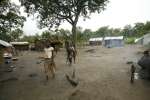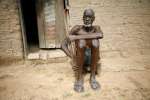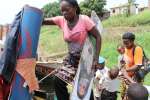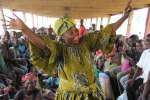Number displaced by violence in Bangui soars past 40,000
News Stories, 1 October 2015
BANGUI, Central African Republic, Oct 1 (UNHCR) – An uneasy calm has returned to the Central African Republic capital of Bangui, but violence and tension has been reported from the provinces and the number of displaced people has soared to more than 40,000 within Bangui, according to the UN refugee agency.
An estimated 42,575 people have been newly displaced in the city since the devastating violence erupted last Saturday after the killing of a Muslim taxi driver, according to figures compiled by UNHCR with the help of IOM, NGO partners and camp managers. Hospital workers and health organizations said the number killed in the violence was at least 41 with more than 260 wounded.
Some 19,000 of these newly displaced found shelter near the airport in the Mpoko site for IDPs, swelling the population there to 30,000. Other sites with large numbers of newly displaced include Centre Jean XXIII, Four Square, Ben-Zvi and Theology Faculty. Many people were returning to these sites.
"We are still unable to reach these people because of the security situation, but we have stocks in Bangui of the most urgently needed items – shelter materials and non-food items such as kitchen sets, blankets and sleeping mats – and are ready to distribute these when given the green light," Leo Dobbs, UNHCR spokesperson in Geneva said.
Extra food rations and hygiene and sanitation items will also be needed if people cannot return home. A few markets in areas with displaced people remain open and accessible, but stocks are low and prices high.
"We again appeal for urgent access to the displaced and for calm on all sides," Dobbs added.
On the streets of Bangui, a few moto taxi drivers were seen today as well as some people braving the streets, but most shops and many markets remain closed. Most of the unauthorised barricades on the main roads in the city have been cleared, allowing for the evacuation of international staff to the MINUSCA base and a hotel.
But MINUSCA troops have come under fire on several occasions. On Wednesday three peace-keepers were injured, two of them severely, after coming under fire in Bangui's 4th District. MINUSCA has helped to evacuate some international aid workers, including 198 from UN agencies, from their residences to the MINUSCA headquarters.
The president of the transitional government, Catherine Samba -Panza, returned to Bangui on Wednesday under heavy security after cutting short her attendance at the UN General Assembly summit in New York and has called for people to return to work.
Meanwhile, UNHCR staff in the divided central town of Bambari said the situation was extremely tense. They reported demonstrations on Tuesday and said 15 to 20 houses had been torched and at least 10 wounded people were seen at the hospital. Tensions were also reported in the towns of Kaga Bandoro, Boali and Berberati, while some 60 detainees escaped from a prison in Bouar.
By Dalia Al Achi, Bangui


















































